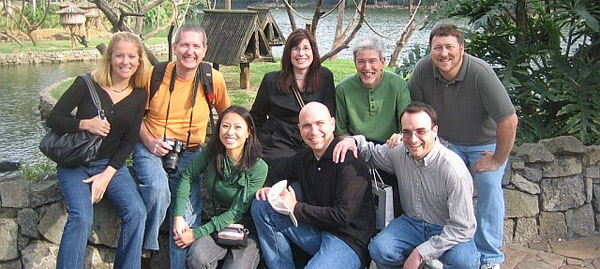EMBAs Gain New-Found Global Business Perspective Abroad

What the College of William & Mary Executive MBA program accomplished in just 11 days in Brazil and Argentina epitomizes what it can accomplish in nearly 20 months.
With only a few weeks remaining in their final semester, students in both the Northern Virginia and Williamsburg classes deemed their May trip abroad a success from an educational, business and cultural standpoint.
"The trip presented a dichotomy of two neighboring countries," Matt Elison, president of the Northern Virginia class, said. "Our time in Sao Paulo really showed us the enormous potential that Brazil has, especially in terms of natural resources and understanding their environmental impact. Buenos Aires, on the other hand, was a great lesson in what the lack of institutional infrastructure can do to an economy."
It's true, the stories you read about in history class seem to come alive. Alexandre Pundek Rocha, who has worked with the Brazilian Central Bank for almost 35 years in monetary policy, discussed important facts to know about Brazil. For example, as the lower class increases, the middle class continues to shrink. In the 90s, people worked and lived just to eat; however the period was also marked by more imports such as cars and cigarettes as the government let up on its regulation, and shortly thereafter the steel and telecommunications' industries took off.
Some Brazilians believe the Kyoto protocol might just be the answer if economic incentives are created to encourage people to stop burning down the Amazon.
The third day of the trip began with a visit to each study group's team consultancy project.
"Participating in an International Consultancy Project with Expor, a Brazilian mannequin manufacturer, gave our team the opportunity to learn about Brazilian business culture, contrast international and U.S. markets, visit the Brazilian countryside and make lasting personal relationships with leaders in manufacturing and exporting," Ann Rohde Payes, the president of the Williamsburg class, said. "The ICP surpassed my expectations and added to the real-world application of the trip."
Other various company visits, such as to Natura, which will turn 40 next year, have incorporated a sustainable development model, a "belief in well being and with the environment. That life is a chain of relationships and everything is interdependent." The company learned that they grew too fast in 2007 at 12 percent. They realize they can't grow at 2.5 times the GDP of Brazil forever.
The class also visited Estado de Sao Paulo, one of Sao Paulo's largest newspapers with a circulation of 240,000, indicative of Sao Paulo's standing as fourth largest city in the world. Born to build a political regime, to support to democracy without slaves, the newspaper has a rich history. The operations manager explained readership in Brazil is not declining as fast as in the United States and they have new readership everyday. With 15 percent growth in ad sales last year, reading a newspaper in Brazil is something you see your mother and father doing as a child and has become a cultural element of the society.
While the class agreed on the benefits of visiting Sao Paulo, Ellison said: "I speak for a lot of people on the trip in saying that I could live in Buenos Aires in a heartbeat. It's an absolutely gorgeous city."
With fall at its peak, the vibrancy showed up in Buenos Aires' trees. Famous landscape architect Carlos Thays of Paris fell in love with Buenos Aires, and later took over as director of parks in the late 1880s, expanding the park system. Under his leadership, some 40,000 roses were planted from different parts of the world.
The importance of Argentine soccer became apparent quite fast. In fact, if you don't know who Maradona is, you better find out fast, because according to the tour guide he is "the most important part of the city."
We saw a lot of art museums, the capital building and the Flower of the City along with Evita's grave. A lot of modern art was juxtaposed against a tint of what seemed like Roman architecture (though, to be exact it was Rococo era). It felt more European than South American.
But some would argue the Malbec, Argentina's red wine topped the list. In fact, the residents seem to agree as domestically, the growth in the wine industry has seen 350 percent.
In one lecture, the class learned Argentina is known for four things: beef, lack of information, lack of capital, and inefficient management. Andres Borentein, chief economist at the British Embassy, helped the class understand Argentina's position in the global economy. Not only 29th in the world economically, Americans are two to three times richer.
"There have been very few normal years for Argentina," he said. "The growth will probably decelerate from the current 7 percent to 3 percent. The problem with Argentina is decisions are not being made now, they are missing their opportunity and the political institution is weak."
This helped students in a practical way, Payes indicated.
"The contrast between Brazilian and Argentine cultures and their views on the United States exemplified regional differences and how as global business leaders we must be sensitive to how U.S. policies, regulations and culture influence business activities," she said.

